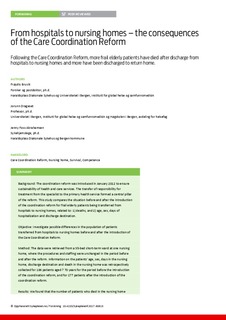| dc.description.abstract | Background: The coordination reform was introduced in January 2012 to ensure sustainability of health and care services. The transfer of responsibility for treatment from the specialist to the primary health service formed a central pillar of the reform. This study compares the situation before and after the introduction of the coordination reform for frail elderly patients being transferred from hospitals to nursing homes, related to: 1) deaths, and 2) age, sex, days of hospitalization and discharge destination.
Objective: Investigate possible differences in the population of patients transferred from hospitals to nursing homes before and after the introduction of the Care Coordination Reform.
Method: The data were retrieved from a 35-bed short-term ward at one nursing home, where the procedures and staffing were unchanged in the period before and after the reform. Information on the patients' age, sex, days in the nursing home, discharge destination and death in the nursing home was retrospectively collected for 186 patients aged ? 70 years for the period before the introduction of the coordination reform, and for 177 patients after the introduction of the coordination reform.
Results: We found that the number of patients who died in the nursing home after hospitalization doubled (27% versus 13%, p##less_than###0.002) following the introduction of the coordination reform. Compared with the situation before the reform, patients admitted after the reform were older (median 88 years (range 73-103) versus 85 years (range 70-99), p###less_than###0.001). Fewer patients were transferred to a different nursing home (21% versus 45%, p ###less_than### 0.001), and more were discharged to their own home (47% versus 36%, p = 0.04).
Conclusion: Our results show that patients transferred from hospitals to nursing homes after the introduction of the coordination reform were older. Moreover, more patients died during short-term stays in nursing homes after being transferred from hospitals. There is reason to assume that these results have consequences for the needs for competence and staffing in nursing homes. | nb_NO |
